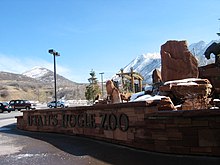Hogle Zoo
 |
|
| Date opened | August 1, 1931 |
|---|---|
| Location | Salt Lake City, Utah, USA |
| Coordinates | 40°44′59″N 111°48′50″W / 40.7498°N 111.814°WCoordinates: 40°44′59″N 111°48′50″W / 40.7498°N 111.814°W |
| Land area | 42 acres (17 ha) |
| No. of animals | 800 |
| No. of species | 249 |
| Memberships | AZA,WAZA |
| Major exhibits | Elephant Encounter, Asian Highlands, Rocky Shores, African Savanna |
| Website | www |
Utah's Hogle Zoo is a 42-acre (17 ha) zoo located in Salt Lake City, Utah. It houses animals from diverse ecosystems. It is located at the mouth of Emigration Canyon. Hogle (pronounced "ho-gul") is an accredited member of the Association of Zoos and Aquariums (AZA) and the World Association of Zoos and Aquariums (WAZA).
The zoo has been at its present location at the mouth of Emigration Canyon since 1931 on land donated by Mr. and Mrs. James A. Hogle. Its original location was in Salt Lake City's Liberty Park. In 1936, the zoo purchased Princess Alice, an elephant, from a traveling circus. She gave birth to the first elephant born in Utah. His name was Prince Utah and he died at eleven months old. Current exhibits include various birds, mammals, and reptiles from around the world.
The zoo is owned by the city of Salt Lake City, and is supported through tax dollars and private donations raised by the Utah Zoological Society.
Hogle Zoo is accredited by the Association for Zoos and Aquariums. Only 10 percent of American zoos are accredited by the AZA. As part of the AZA, Hogle Zoo must abide by strict husbandry, education, and guest service requirements. The AZA has to approve any exhibits the zoo wants to create. It even has to approve the enrichment and food that is given to the animals. All the animals in AZA zoos are technically "owned" by the AZA. Animals are only moved within other AZA zoos.
Most of the animals at Hogle Zoo have a Species Survival Plan, which is run under the AZA, and ensures genetic diversity for certain species. The SSP pairs animals together for mating based on their hereditary and gene pool. For example, Nabu and Baron, Hogle Zoo’s female and male lions, were paired by the Lion Species Survival Plan. They were given the "okay" to mate by the SSP, because they had different genes, insuring genetically diverse offspring. This resulted in the birth of the zoo's lion cubs in 2016. The majority of animals with Species Survival Plans are animals that are near the threat of endangerment or near the threat of extinction.
The zoo has had many births over the years. The zoo participates in SSPs (Species Survival Plans), meaning that animal breeding must be approved by an SSP. So they have many breeding plans. Here are a few.
...
Wikipedia
